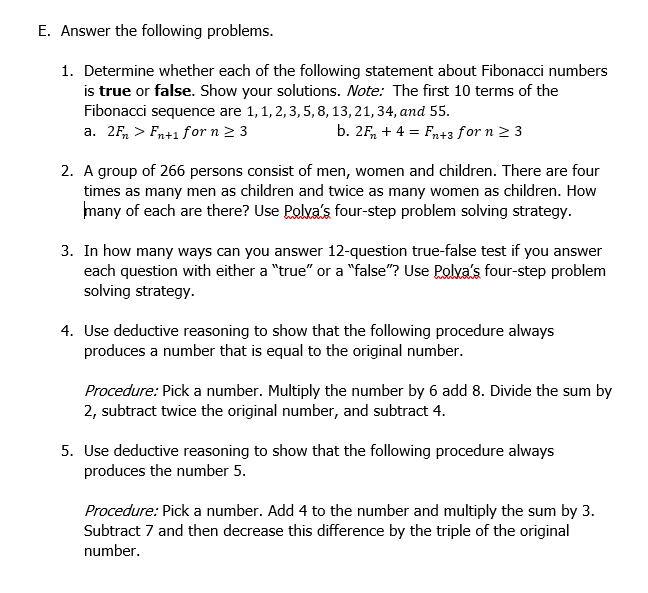1. Determine whether each of the following statement about Fibonacci numbers is true or false. Show your solutions. Note: The first 10 terms of the Fibonacci sequence are 1,1, 2,3, 5, 8, 13, 21, 34, and 55. a. 2F, > Fn+1 for n 2 3 b. 2F, + 4 = Fn+3 for n 2 3
1. Determine whether each of the following statement about Fibonacci numbers is true or false. Show your solutions. Note: The first 10 terms of the Fibonacci sequence are 1,1, 2,3, 5, 8, 13, 21, 34, and 55. a. 2F, > Fn+1 for n 2 3 b. 2F, + 4 = Fn+3 for n 2 3
Algebra for College Students
10th Edition
ISBN:9781285195780
Author:Jerome E. Kaufmann, Karen L. Schwitters
Publisher:Jerome E. Kaufmann, Karen L. Schwitters
Chapter14: Sequences And Mathematical Induction
Section14.1: Arithmetic Sequences
Problem 78PS
Related questions
Topic Video
Question

Transcribed Image Text:E. Answer the following problems.
1. Determine whether each of the following statement about Fibonacci numbers
is true or false. Show your solutions. Note: The first 10 terms of the
Fibonacci sequence are 1,1, 2,3, 5,8, 13, 21, 34, and 55.
a. 2F, > Fn+1 for n 2 3
b. 2F, + 4 = Fr+3 for n 2 3
2. A group of 266 persons consist of men, women and children. There are four
times as many men as children and twice as many women as children. How
many of each are there? Use Polya's four-step problem solving strategy.
3. In how many ways can you answer 12-question true-false test if you answer
each question with either a "true" or a "false"? Use Polva's four-step problem
solving strategy.
4. Use deductive reasoning to show that the following procedure always
produces a number that is equal to the original number.
Procedure: Pick a number. Multiply the number by 6 add 8. Divide the sum by
2, subtract twice the original number, and subtract 4.
5. Use deductive reasoning to show that the following procedure always
produces the number 5.
Procedure: Pick a number. Add 4 to the number and multiply the sum by 3.
Subtract 7 and then decrease this difference by the triple of the original
number.
Expert Solution
This question has been solved!
Explore an expertly crafted, step-by-step solution for a thorough understanding of key concepts.
Step by step
Solved in 3 steps

Knowledge Booster
Learn more about
Need a deep-dive on the concept behind this application? Look no further. Learn more about this topic, advanced-math and related others by exploring similar questions and additional content below.Recommended textbooks for you

Algebra for College Students
Algebra
ISBN:
9781285195780
Author:
Jerome E. Kaufmann, Karen L. Schwitters
Publisher:
Cengage Learning

Algebra & Trigonometry with Analytic Geometry
Algebra
ISBN:
9781133382119
Author:
Swokowski
Publisher:
Cengage

College Algebra (MindTap Course List)
Algebra
ISBN:
9781305652231
Author:
R. David Gustafson, Jeff Hughes
Publisher:
Cengage Learning

Algebra for College Students
Algebra
ISBN:
9781285195780
Author:
Jerome E. Kaufmann, Karen L. Schwitters
Publisher:
Cengage Learning

Algebra & Trigonometry with Analytic Geometry
Algebra
ISBN:
9781133382119
Author:
Swokowski
Publisher:
Cengage

College Algebra (MindTap Course List)
Algebra
ISBN:
9781305652231
Author:
R. David Gustafson, Jeff Hughes
Publisher:
Cengage Learning

Glencoe Algebra 1, Student Edition, 9780079039897…
Algebra
ISBN:
9780079039897
Author:
Carter
Publisher:
McGraw Hill